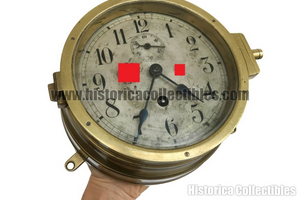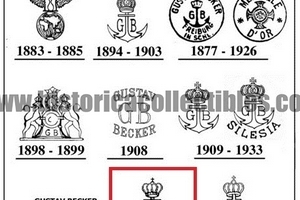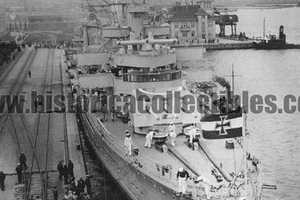Schiffsuhr Gustav Becker, Reichsmarine, Weimar Republik, 1927
Schiffsuhr produced by Gustav Becker, considered one of the world's largest clockmakers, for the Reichsmarine of the Weimar Republic.
In fact, in addition to being the only known specimen, this clock is a very important historical testimony to the events that followed the First World War. With the Treaty of Versailles, signed in the Paris Peace Conference of 1919-1920 and signed by 44 States on 28 June 1919 in Versailles, divided into 16 parts and consisting of 440 articles, the German peace delegation accepted heavy Military reductions, heavy payments for war repairs and the so-called "Germany as the only responsibility for the outbreak of war." The Treaty of Versailles, in addition to abolishing the conscription for Germany, also posed major restrictions on the German armed forces, which should not exceed 100,000 units and a drastic reduction in the production of war material.
On October 1, 1924, Admiral Paul Behncke was replaced by Vice-Admiral Hans Zenker. In May 1925 the first unit of the Möwe class was set up, a series of large, high-torpedoes including Twelve units built by August 1929 to replace the destroyers of the time of the First World War, while between April and August 1926 the three new light cruisers of the Königsberg class were put in the yard, then entered service at the end of the 1920s.
In the realization of these units, the quality limits imposed by the Treaty of Versailles were ably respected, but ably exploited the loophole offered by the Washington Treaty of 6 February 1922: in the case of shipbuilding, the treaty (of which Germany was not part but to which all the main Naval powers of the period joined) based the calculation of the displacement on the "empty" ship, without considering ammunition, fuel, supplies and crew weight; a remarkable difference that could be well exploited by German designers (for example, the Königsberg had a displacement of just over 6,000 tonnes in vacuum but of 7800 tonnes with full load).
The adoption of innovative construction techniques, such as the construction of the hull by welding rather than by riveting or nailing, allowed further weight savings; The welding technique, which then became a constructive standard, also greatly accelerated the time for ships to be built, since it found its maximum application in terms of resource optimization in the construction of Liberty vessels, even though it made the hull less elastic.
The serial number of this clock puts it as a product exactly in 1927, the last year in which Becker owned the brand and the date after which, given the excellence in the mechanical field, the company was bought by the largest clockmaking factory in the world of the time, Junghans Uhren GmbH.
It follows that this very rare clock was certainly commissioned by the Reichsmarine to be installed on board one of the 3 light cruisers of the Königsberg class, composed of three units, set out between 1927 and 1928:
- Königsberg (Launched in 1927)
- Karlsruhe (Launched in 1927)
- Köln (Launched in 1928)
It also excludes the installation on lightweight board Köln, which was launched in 1928. Therefore, being the same clock produced in 1927, it was definitely installed on board one of the two ships launched in the same year, namely the Königsberg or The Karlsruhe.
On the dial is number "7" indicating probably the location, in front of a log on the ship.
The clock is perfectly functional and well preserved.
Reichsmarine or Weimar Navy:
Reichsmarine was the name assumed by the German Reich navy from 1919 until 1935, the year in which Adolf Hitler announced the birth of the Kriegsmarine.
At the end of the First World War, the military units of the German Empire had largely disintegrated as fighting forces and the new Weimar Republic, following the quantitative and qualitative limitations imposed by the Treaty of Versailles, could only have at its disposal a military with purely defensive capabilities; a decree of 6 March 1919 therefore established the establishment of a Vorläufige Reichswehr, including a Vorläufige Reichsheer (the land forces) and a Vorläufige Reichsmarine. The name Reichsmarine was then officially assumed by the naval forces on 23 March 1921.
Under the direction of Admirals Paul Behncke and Hans Zenker, the Reichsmarine was reorganized as a fighting force in spite of the strong limits imposed by the Treaty of Versailles: the few old units granted were put back into working order, and starting from the early 1920s it began the design and construction of new concept ships; at the same time, the German military leaders launched a series of secret programs aimed at illegally circumventing the clauses imposed by the Allies, in particular regarding the development and training in the use of prohibited armaments, first and foremost submarines.
In 1933, following the appointment of Adolf Hitler as Reich Chancellor, the expansion program was further strengthened as Germany progressively freed itself from the limits imposed following the First World War; in 1935, with the complete rejection of the Treaty of Versailles and the establishment of new German armed forces, the old Reichsmarine then took on the new designation of Kriegsmarine "War Navy".






